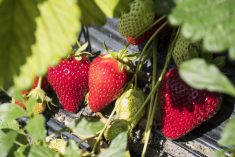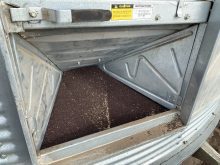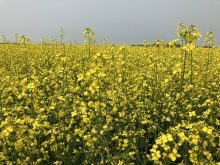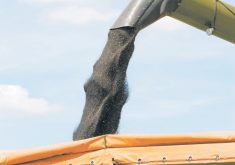Somehow, the name Chinese gooseberry didn’t quite fit the bill for a fruit grown in New Zealand.
Was it a real gooseberry? Was it from China? Was it part of a communist plot to raise funds? Was it subject to berry tariffs or possibly a melon tax?
These were the questions that plagued the furry brown fruit until June of 1959, when producer Jack Turner suggested rechristening what was then called Hayward’s Chinese gooseberry as the modern kiwifruit. There was only one problem.
“It didn’t become part of our intellectual property,” said Mark Gardiner of Whitehall Fruit Packers, New Zealand’s largest producer of organic kiwifruit. “It’s a pity we didn’t make use of that… now just everyone has kiwifruit, Italy and Chile and everywhere, even though that particular cultivar came from New Zealand.”
Read Also

Manitoba sclerotinia picture mixed for 2025
Variations in weather and crop development in this year’s Manitoba canola fields make blanket sclerotinia outlooks hard to pin down
In fact, New Zealand is no longer even the world’s largest kiwifruit producer — Italy is.
But that doesn’t mean New Zealand growers, who sell through a single-desk system under the brand name Zespri, are letting go of the country’s namesake fruit. Zespri has partnerships with growers in Italy, France, Japan, South Korea and Australia. It has also trademarked and protected new golden varieties of the kiwifruit to ensure it can capitalize on future growth in the industry by protecting intellectual property.
Currently, Zespri’s biggest competition comes from Chile where it does not have any partnerships.
“Their cost of production is somewhere close to 50 per cent of ours,” said Zespri’s chief operating officer, Simon Limmer. But he added the Chilean threat doesn’t just come on the basis of price and market share.

Limmer said the biggest danger with kiwifruit from Chile is that it could turn people off from the fruit altogether as a result of different harvesting and shipping practices that see fruit hit grocery store shelves before it’s actually ripe and ready to eat.
“If you have that bad eating experience of a sour green, hard kiwifruit… you don’t come back in a hurry,” he said, adding that Zespri kiwifruit are sold at premium that works to guarantee only ripe, sweet fruit make it to market. Innovative packaging that cradles the fruit is also used to ensure it survives shipping — some packaging also includes a tiny spoon and knife combination, in addition to instructions on how to best eat the fruit’s bright flesh.
About seven per cent of Zespri’s revenue goes back into marketing, Limmer said.
“The real focus is on taste and on nutrition,” he said, adding they are also working on inroads to Chinese markets. Not surprisingly, the Chinese gooseberry is widely grown in China, but the country doesn’t export and there is a growing opportunity there for premium products.

But in the short term, the biggest issue facing New Zealand’s kiwifruit industry is PSA, or Pseudomonas syringae pv. actinidiae. The bacterial disease wiped out 100 per cent of the fruit’s golden variety in Italy by 2011, only three years after being discovered there. It then destroyed 90 per cent of the golden orchards in New Zealand.
The industry is rebuilding with a new, resistant golden kiwifruit variety. But Gardiner said living with the disease has become a reality.
“It’s still a challenge, right now we’ve got people out there cutting out vines, and cutting out bits and pieces that have PSA,” he said, adding the new variety combined with fresh approaches to biosecurity and disease removal have been key to recovering.
“In New Zealand, people think about biosecurity all the time — but really only when coming and going from the country,” said Shane Max, Zespri’s orchard productivity manager. “With PSA people had to think about it going from one orchard to another, they had to suit up to visit a neighbour… and that was all new.”
While orchards are recovering, the costs of dealing with PSA are still cutting into grower income. Gardiner said as a larger producer, he has the scale to keep making a living, but that some smaller producers left the industry.
Despite the setback, New Zealand’s kiwifruit industry has still doubled production over the last 15 years. The last season saw 2,500 growers produce 450,000 tonnes of kiwifruit on about 3,000 orchards, mostly in the Bay of Plenty region, and Zespri now sells in more than 50 countries.
“I planted my first kiwifruit when I was still a single man, back in 1975,” said Gardiner. “Young and ambitious, and foolish.”
Today, Gardiner and his wife Robyn have packing facilities in addition to nearly 200 hectares of kiwifruit orchards in the Waikato region. Innovations such as hail canopies, using sheep for weed control and girdling vines for sweeter fruit have all played a role in the operation’s success, despite trials like disease and the sale of one farm during a period of high interest rates.
“We’ve just taken opportunities as they’ve arisen,” said Gardiner. “There will be more challenges, but I think there will also be a lot more opportunities.”



















